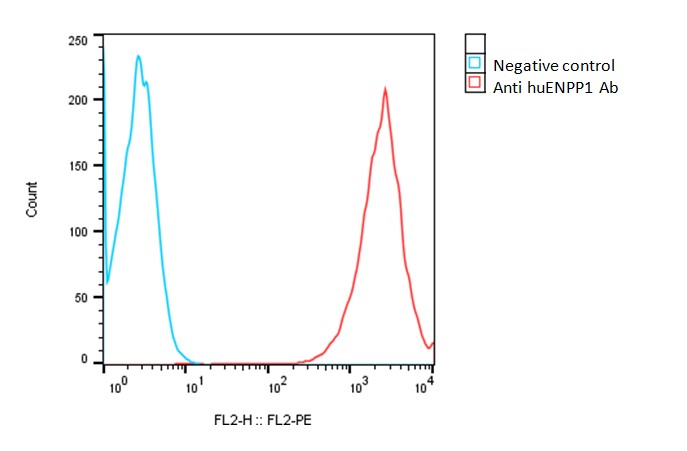
| Catalog Number | Product | Size | Price | |
|---|---|---|---|---|
| C3050 | Human ENPP1-CHO-K1 Stable Cell Line | 2 vials | $3950 | Order |
| Catalog Number | C3050 |
|---|---|
| Cell Line Name | Human ENPP1-CHO-K1 stable cell line |
| Accession Number | NP_006199.2 |
| Host Cell | Adherent CHO-K1 |
| Quantity | Two vials of frozen cells (2x106 per vial) |
| Culture Medium | DMEM with 10% FBS, 4 µg/ml puromycin |
| Freezing Medium | 90% FBS and 10% DMSO |
| Storage | Liquid nitrogen upon receipt |
| Product Datasheet: | Download PDF |
Detection of human ENPP1 expression on human ENPP1-CHO-K1 stable cells using a monoclonal antibody specific for human ENPP1 (Accurus Cat. #A1022), followed by staining with PE anti-human IgG antibody.

ENPP1 (Ectonucleotide Pyrophosphatase/Phosphodiesterase 1, PDNP1, PC1, PCA1, M6S1, LY41, CD203a) is a membrane-bound glycoprotein that belongs to the family of ectonucleotide pyrophosphatase/phosphodiesterase (ENPP) enzymes. ENPP1 is involved in a variety of physiological processes including bone mineralization, insulin signaling, and inflammation and is expressed in many tissues including bone, liver, adipose, and cartilage. ENPP1 has both pyrophosphatase and phosphodiesterase activities and plays a crucial role in regulating the levels of extracellular pyrophosphate, a mineralization inhibitor, in tissues such as bone and cartilage. It also serves as an inhibitor of insulin signaling, leading to insulin resistance in adipose tissue and skeletal muscle. In addition, ENPP1 has been implicated in cell adhesion, inflammation, and matrix calcification. ENPP1 is frequently overexpressed in local relapses and tumor metastases, which are associated with poor prognosis and survival in a range of solid tumors. ENPP1 promotes an immunosuppressive tumor microenvironment (TME) by tilting the balance of ATP/adenosine (Ado) in conjunction with other components (CD38, CD39/ENTPD1, and CD73/NT5E). Moreover, ENPP1 intersects with the stimulator of interferon genes (STING), impairing its robust immune response through the hydrolysis of the effector 2',3'-cyclic GMP–AMP. Thus, ENPP1 blockade emerges as a unique target eliciting immune remodeling and leveraging the STING pathway for cancer treatment.
Roberts F, Zhu D, Farquharson C, Macrae VE. ENPP1 in the Regulation of Mineralization and Beyond. Trends Biochem Sci. 44:616-628. 2019.
Bacci S, De Cosmo S, Prudente S, Trischitta V. ENPP1 gene, insulin resistance and related clinical outcomes. CurrOpin Clin NutrMetab Care. 10:403-9. 2007.
Li J, et al. Metastasis and Immune Evasion from Extracellular cGAMP Hydrolysis. Cancer Discov. 11:1212-1227. 2021.
Chu X, Baek DS, Li W, Shyp T, Mooney B, Hines MG, Morin GB, Sorensen PH, Dimitrov DS. Human antibodies targeting ENPP1 as candidate therapeutics for cancers. Front Immunol. 14:1070492. 2023.